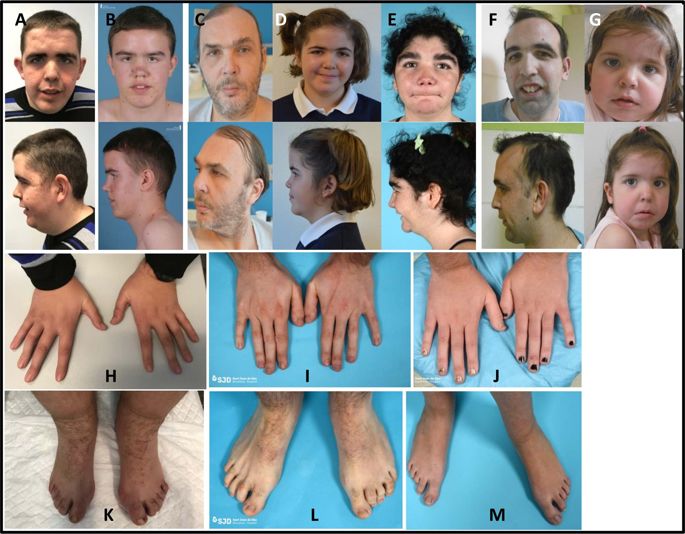European Journal of Human Genetics ( IF 5.2 ) Pub Date : 2019-11-04 , DOI: 10.1038/s41431-019-0485-3 Jair Tenorio 1, 2 , Pablo Alarcón 3 , Pedro Arias 1, 2 , Irene Dapía 1, 2 , Sixto García-Miñaur 1, 2 , María Palomares Bralo 1, 2 , Jaume Campistol 4 , Salvador Climent 5 , Irene Valenzuela 6, 7 , Sergio Ramos 1, 2 , Antonio Martínez Monseny 8 , Fermina López Grondona 6 , Javier Botet 9 , Mercedes Serrano 2, 4, 8 , Mario Solís 1, 2 , Fernando Santos-Simarro 1, 2 , Sara Álvarez 9 , Gisela Teixidó-Tura 6 , Alberto Fernández Jaén 10 , Gema Gordo 1, 2 , María Belén Bardón Rivera 11 , Julián Nevado 1, 2 , Alicia Hernández 1, 2 , Juan C Cigudosa 9 , Víctor L Ruiz-Pérez 2, 12 , Eduardo F Tizzano 7 , , Pablo Lapunzina 1, 2

|
Tatton-Brown-Rahman (TBRS) syndrome is a recently described overgrowth syndrome caused by loss of function variants in the DNMT3A gene. This gene encodes for a DNA methyltransferase 3 alpha, which is involved in epigenetic regulation, especially during embryonic development. Somatic variants in DNMT3A have been widely studied in different types of tumors, including acute myeloid leukemia, hematopoietic, and lymphoid cancers. Germline gain-of-function variants in this gene have been recently implicated in microcephalic dwarfism. Common clinical features of patients with TBRS include tall stature, macrocephaly, intellectual disability (ID), and a distinctive facial appearance. Differential diagnosis of TBRS comprises Sotos, Weaver, and Malan Syndromes. The majority of these disorders present other clinical features with a high clinical overlap, making necessary a molecular confirmation of the clinical diagnosis. We here describe seven new patients with variants in DNMT3A, four of them with neuropsychiatric disorders, including schizophrenia and psychotic behavior. In addition, one of the patients has developed a brain tumor in adulthood. This patient has also cerebral atrophy, aggressive behavior, ID, and abnormal facial features. Clinical evaluation of this group of patients should include a complete neuropsychiatric assessment together with psychological support in order to detect and manage abnormal behaviors such as aggressiveness, impulsivity, and attention deficit-hyperactivity disorder. TBRS should be suspected in patients with overgrowth, ID, tall stature, and macrocephaly, who also have some neuropsychiatric disorders without any genetic defects in the commonest overgrowth disorders. Molecular confirmation in these patients is mandatory.
中文翻译:

由于 DNMT3A 中的致病变异,进一步描述了 Tatton-Brown-Rahman 综合征的神经精神学发现:七名新患者。
Tatton-Brown-Rahman (TBRS) 综合征是最近描述的一种过度生长综合征,由DNMT3A基因中的功能变体丧失引起。该基因编码 DNA 甲基转移酶 3 α,该酶参与表观遗传调控,尤其是在胚胎发育过程中。DNMT3A中的体细胞变异体已在不同类型的肿瘤中得到广泛研究,包括急性髓性白血病、造血和淋巴癌。该基因中的生殖系功能获得变体最近与小头性侏儒症有关。TBRS 患者的常见临床特征包括身材高大、大头畸形、智力障碍 (ID) 和独特的面部外观。TBRS 的鉴别诊断包括 Sotos、Weaver 和 Malan 综合征。这些疾病中的大多数表现出具有高度临床重叠的其他临床特征,因此有必要对临床诊断进行分子确认。我们在此描述了 7 名具有DNMT3A变异的新患者,其中四人患有神经精神疾病,包括精神分裂症和精神病行为。此外,其中一名患者在成年后患上了脑瘤。该患者还患有脑萎缩、攻击性行为、ID 和异常面部特征。对这组患者的临床评估应包括完整的神经精神评估和心理支持,以检测和管理异常行为,如攻击性、冲动和注意力缺陷多动障碍。对于患有过度生长、ID、身材高大和大头畸形的患者,应怀疑 TBRS,这些患者也有一些神经精神疾病,而在最常见的过度生长障碍中没有任何遗传缺陷。这些患者的分子确认是强制性的。



























 京公网安备 11010802027423号
京公网安备 11010802027423号